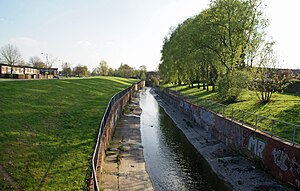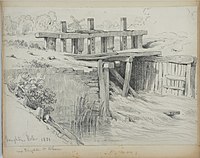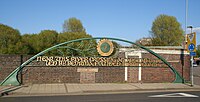River Rea: Difference between revisions
No edit summary |
No edit summary |
||
| Line 7: | Line 7: | ||
The Rea rises in the [[Waseley Hills]] (in the Waseley Hill Country Park) in [[Worcestershire]] – its source is well signposted from the car park there. The river drops about 230 feet in its first mile, but from then on has a very gentle slope. | The Rea rises in the [[Waseley Hills]] (in the Waseley Hill Country Park) in [[Worcestershire]] – its source is well signposted from the car park there. The river drops about 230 feet in its first mile, but from then on has a very gentle slope. | ||
The river's tributaries include Callow Brook, the Bourne (which begins as Merritts Brook before joining Griffins Brook) and Bourne Brook. From [[Rubery]], the river flows into Birmingham near the former Rover works at [[Longbridge]], then flows through a tunnel under the A38. In [[ | The river's tributaries include Callow Brook, the Bourne (which begins as Merritts Brook before joining Griffins Brook) and Bourne Brook. From [[Rubery]], the river flows into Birmingham near the former Rover works at [[Longbridge]], then flows through a tunnel under the A38. In [[Northfield]], south of Birmingham city centre, the Rea is crossed by one its few remaining fords, at The Mill Walk, near Hawkesley Mill Lane. | ||
Below | Below Northfield, the river valley is also used by the railway to [[Kings Norton]]. | ||
[[File:Lines family sketchbook - Vaughton Hole 010.jpg|right|thumb|200px|A floodgate on the river at Vaughton’s Hole drawn in 1831]] | [[File:Lines family sketchbook - Vaughton Hole 010.jpg|right|thumb|200px|A floodgate on the river at Vaughton’s Hole drawn in 1831]] | ||
| Line 22: | Line 22: | ||
{{commons|River Rea, West Midlands}} | {{commons|River Rea, West Midlands}} | ||
*[http://www.riverreatrail.org.uk River Rea Trail] | *[http://www.riverreatrail.org.uk River Rea Trail] | ||
*[http://www.flickr.com/photos/52067454@N00/427326615/ Photo of the Rea at Fazeley St., Birmingham] | *[http://www.flickr.com/photos/52067454@N00/427326615/ Photo of the Rea at Fazeley St., Birmingham 5] | ||
[[Category:Rivers of Warwickshire|Rea]] | [[Category:Rivers of Warwickshire|Rea]] | ||
[[Category:Rivers of Worcestershire|Rea]] | [[Category:Rivers of Worcestershire|Rea]] | ||
Latest revision as of 11:41, 29 August 2017
- Not to be confused with River Rea, Shropshire

The River Rea (pronounced "ray") is a small river, yet one which stretches for 14 miles through two counties, through country and town and which ultimately passes through Birmingham in Warwickshire on its way to join the River Tame. The name of the river derives from a root found in many Indo-European languages and means "to run" or "to flow". It frequently bursts its banks after heavy rain.
Course
The Rea rises in the Waseley Hills (in the Waseley Hill Country Park) in Worcestershire – its source is well signposted from the car park there. The river drops about 230 feet in its first mile, but from then on has a very gentle slope.
The river's tributaries include Callow Brook, the Bourne (which begins as Merritts Brook before joining Griffins Brook) and Bourne Brook. From Rubery, the river flows into Birmingham near the former Rover works at Longbridge, then flows through a tunnel under the A38. In Northfield, south of Birmingham city centre, the Rea is crossed by one its few remaining fords, at The Mill Walk, near Hawkesley Mill Lane.
Below Northfield, the river valley is also used by the railway to Kings Norton.


Wychall Reservoir, near the river at Kings Norton, was built in the early 19th century by the Worcester Canal Company after mill owners claimed that water was being taken from the river to fill the canal and reducing the working effectiveness of their mills. Following Kings Norton, the river flows through Stirchley. It is now culverted for much of its course through Birmingham. It enters Warwickshire in the suburbs and passes through the Pebble Mill area and Cannon Hill Park then Calthorpe Park.
A pair of decorative arches on the bridge where Gooch Street crosses the river mark the first settlement of Birmingham. In the Middle Ages, Birmingham was a mere hamlet, and was built at a crossing on the Rea in what is now Digbeth. Many of the street names in the area refer to the river or its mills. These include Rea Street, Floodgate Street, River Street and Duddeston Mill Road. There are proposals to include a riverside walk and new bridge over the Rea at Digbeth's Custard Factory media and arts complex (now complete). There are also proposals for the river to be uncovered at the Warwick Bar area of Digbeth.
Near Gravelly Hill Interchange, about 14 miles from its source, the Rea merges with the River Tame, which takes its waters by way of the Trent and the Humber to the North Sea.
Outside links
| ("Wikimedia Commons" has material about River Rea) |
